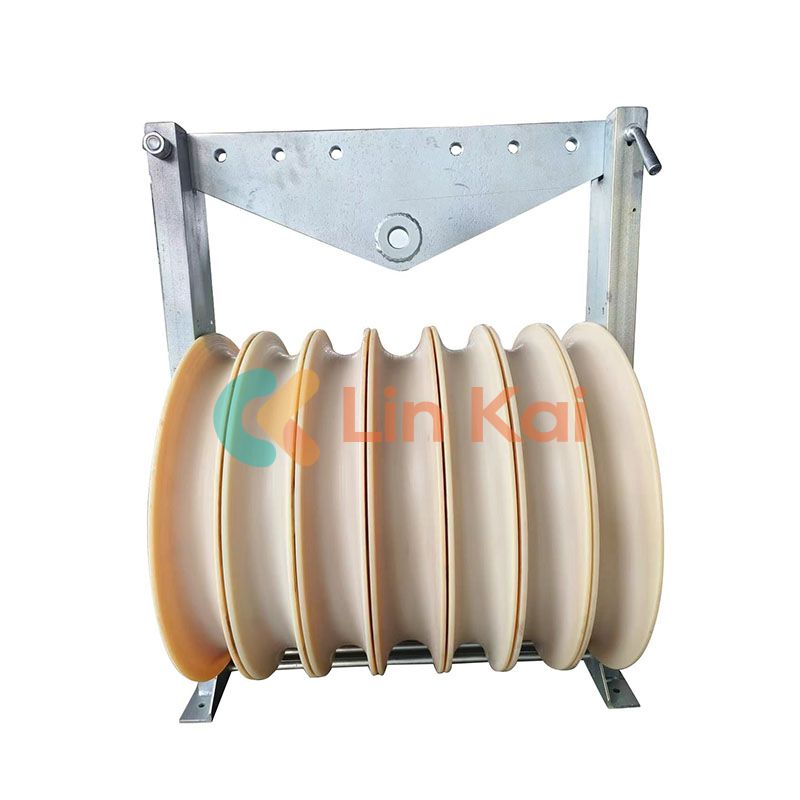
- English
- Español
- Português
- русский
- Français
- 日本語
- Deutsch
- tiếng Việt
- Italiano
- Nederlands
- ภาษาไทย
- Polski
- 한국어
- Svenska
- magyar
- Malay
- বাংলা ভাষার
- Dansk
- Suomi
- हिन्दी
- Pilipino
- Türkçe
- Gaeilge
- العربية
- Indonesia
- Norsk
- تمل
- český
- ελληνικά
- український
- Javanese
- فارسی
- தமிழ்
- తెలుగు
- नेपाली
- Burmese
- български
- ລາວ
- Latine
- Қазақша
- Euskal
- Azərbaycan
- Slovenský jazyk
- Македонски
- Lietuvos
- Eesti Keel
- Română
- Slovenski
- मराठी
- Srpski језик
Stringing Block Maintenance and Inspection Best Practices
2025-08-15
Proper maintenance of conductor pulley stringing blocks is critical for ensuring safety and efficiency in power line construction and maintenance operations. This comprehensive guide from Lingkai covers essential maintenance procedures, inspection protocols, and technical specifications for optimal performance of your conductor pulley stringing blocks. We'll explore proper cleaning techniques, wear detection methods, load capacity considerations, and storage best practices to maximize equipment lifespan and operational safety.
1. Understanding Conductor Pulley Stringing Block Specifications
Lingkai's conductor pulley stringing blocks are engineered for durability and performance in demanding power transmission applications. Our products meet international standards with these key technical parameters:
Standard Product Line Specifications
| Model | Sheave Diameter | Max Load (kN) | Weight (kg) | Bearing Type | Cable Diameter Range |
|---|---|---|---|---|---|
| LK-SB200 | 200mm | 20 | 4.5 | Sealed Ball | 8-12mm |
| LK-SB350 | 350mm | 50 | 12.8 | Tapered Roller | 12-24mm |
| LK-SB500 | 500mm | 100 | 28.5 | Double Row Roller | 24-50mm |
Premium Features:
-
Hardened steel sheaves (HRC 55-60)
-
Corrosion-resistant aluminum alloy frames
-
Self-lubricating bearing systems
-
UV-stabilized nylon side plates
-
Integrated rotation indicators
2. Routine Maintenance Procedures
Cleaning and Lubrication Schedule
| Component | Cleaning Method | Lubricant Type | Frequency |
|---|---|---|---|
| Sheave Surface | Solvent wipe | Dry film lubricant | After each use |
| Bearing Assembly | Ultrasonic cleaning | High-temp grease | Every 200 hours |
| Frame Joints | Brush cleaning | Anti-seize compound | Monthly |
| Swivel Mechanism | Pressure wash | Penetrating oil | Quarterly |
Critical Maintenance Steps:
-
Remove all dirt and metal particles from sheave grooves
-
Inspect for groove wear using profile gauges
-
Verify smooth rotation without binding
-
Check all fasteners for proper torque
-
Test swivel mechanism for full range of motion
3. Comprehensive Inspection Protocols
Wear and Damage Assessment
Visual Inspection Checklist:
✔ Sheave groove deformation (max 1mm deviation)
✔ Bearing play (max 0.5mm radial movement)
✔ Frame cracks or distortion
✔ Rope guide wear indicators
✔ Corrosion on critical components
Measurement Standards:
| Parameter | Acceptable Tolerance | Rejection Criteria |
|---|---|---|
| Sheave OD | ±2% of nominal | >3% reduction |
| Groove Depth | +0/-1mm | >1.5mm wear |
| Bearing Rotation Torque | <5Nm | >8Nm resistance |
| Frame Alignment | ±1° | >2° misalignment |
4. Storage and Handling Best Practices
Proper Storage Conditions
-
Temperature range: -20°C to +40°C
-
Relative humidity: <60% RH
-
Protection from direct sunlight
-
Elevated storage (minimum 10cm above ground)
-
Periodic rotation of unused units
Transportation Guidelines
✔ Use original packaging when possible
✔ Secure all moving parts
✔ Protect sheave surfaces with covers
✔ Avoid shock loads during handling
✔ Separate metal components with padding
Why Choose Lingkai Conductor Pulley Stringing Blocks?
✔ ISO 9001 certified manufacturing
✔ 100% load testing before shipment
✔ Custom configurations available
✔ 5-year structural warranty
✔ Global technical support network
Contact Our Power Transmission Experts:
📧 Email: nbtransmission@163.com
With 25 years of experience in power line equipment manufacturing, I personally guarantee Lingkai conductor pulley stringing blocks deliver unmatched reliability when properly maintained. Our team is ready to assist with your specific maintenance challenges and equipment needs.




